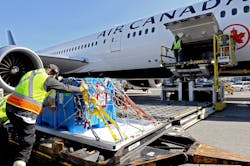How to Handle Animals with Care
Animals have been transported by air since the early-1930s and in today’s modern world, officials at the International Air Transport Association (IATA) say moving animals by air is considered the most humane and expedient method of transportation over long distances.
In recent decades, the frequency of animals transported by aircraft has been increasing. Sonia Ben Hamida, head of special cargo at IATA, says the increase is in part due to globalization, the increased mobility of people and global conservation efforts.
“When it comes to transporting animals, it is not just about moving them from A to B,” Ben Hamida says. “It is about recreating their natural environment, ensuring their physiological and psychological well-being, and making sure they arrive at their destination in the best possible condition. It is a major responsibility, involving science, logistics and compassion."
Further, she says the transport of endangered species often stands for an even larger mission – the survival of their species or the restoration of a natural habitat.
Because ground handlers play a key role in the complex process of live animal transportation, Ben Hamida encourages regular training to keep updated with the latest IATA regulations and best practices. IATA member airlines commit to comply with IATA’s Live Animals Regulations (LAR). What’s more, the IATA Center of Excellence for Independent Validators (CEIV) for Live Animals Logistics certification, open to all, ensures that organizations meet the standards set by the LAR.
The 2024 Edition of IATA’s Live Animals Regulations marks an important milestone for IATA and the aviation industry.
“It signifies 50 years of dedicated effort to ensure that live animals, when transported by air, are handled and carried in a manner which accounts for their welfare, safety and comfort,” Ben Hamida says.
During this time, she says there has been a significant shift towards prioritizing animal welfare.
“Recent editions have incorporated extensive research on animal behavior and physiology to ensure their well-being during transport,” she says.
As IATA’s understanding of different animal species has grown, including learning behaviors, stressors and comfort needs, regulations have become more detailed. Today, for example, there are 61 container requirements for different types of animals.
Some animals can travel in the cabin, some cannot.
Recently, the number of passengers traveling with emotional support animals (ESAs) has increased. Note emotional support animals are not the same as service animals.
“Service animals are trained to perform tasks and have specific rights under federal laws in many countries,” Ben Hamida says. “While emotional support animals are not necessarily trained and offer comfort and support to their owners. Their status can differ significantly.”
Individual airlines determine the specifications and conditions to handle ESAs. That includes the types of ESAs they allow, how ESAs are accommodated in the cabin and whether additional documentation or verification is required. Containers must comply with the LAR container requirements. That means containers must be secure, well-ventilated and comfortable for the animal.
Ground handlers must know which animals are accepted in-cabin; what documentation is required; and how animals should be accommodated.
To increase awareness of the responsibilities and requirements of in-cabin animal transport, IATA developed an in-cabin live animal checklist, and after a year-long transition, the checklist in 2023 became a mandatory LAR requirement. According to Ben Hamida, the result has been more consistent practices and enhanced awareness.
She says, here, the emphasis for ground handlers is to ensure that personnel are trained on the checklist's specifics and understand its significance; to communicate proactively with passengers to avoid any last-minute confusion or non-compliance; and to provide their feedback on the checklist's effectiveness, any challenges faced or areas of potential improvement to IATA.
The 2024 LAR edition features significant changes, including updates to documentation, container requirements and marking.
For documentation, the IATA live animal acceptance checklist for cargo is distinguished from the in-cabin checklist. The checklist specifies marking containers carrying animals that can inflict poisonous or venomous bites or stings. Also, information pertaining to the use of sedatives or tranquilizers is required.
For container requirements, stocking density guidelines have been revised for pigs and Container Requirement 3 has multiple amendments from accepted construction materials to precise instructions for bulk transport and loading density for horses.
Ben Hamida says there has been a more concerted effort to involve various stakeholders in the LAR's development including veterinarians, animal welfare organizations and zoological experts.
“Their insights and real-world experiences have played a crucial role in shaping a more holistic and informed approach to animal transport,” she says.
Training and certifying personnel involved in the transportation of live animals has increasingly been emphasized.
“This ensures that everyone involved understands and adheres to the highest standards of care,” Ben Hamida says.
IATA’s CEIV for Live Animals Logistics certification process requires training, an assessment and validation.
“Entities wishing to obtain this certification must undergo a rigorous evaluation process,” Ben Hamida says, noting this certification is open to all, and not exclusive to IATA members. “Once certified, they showcase a commitment to excellence in live animal transportation and animal welfare. It reflects the collective commitment of the aviation industry to treat animals with the respect and care.”
In the beginning of September, Ben Hamida reported there were 29 organizations with this certification including seven airlines, 10 cargo handling facilities, four ramp handlers and eight freight forwarders.
“Training is essential and remains at the core of ensuring the welfare of animals,” Ben Hamida concludes. “It is important that ground handling personnel undergo regular training to remain updated with the latest IATA regulations and best practices.
“The safety of animals must never be compromised. Procedures are in place to avoid distress or harm to the animals.
“As discussed, the illegal wildlife trade poses a significant challenge. Ground handlers, being on the front lines, should be vigilant and proactive in identifying and reporting any suspicious shipments.
“The role of ground handlers is pivotal in shaping the experience of live animals during air transport by being skilled and proactive.”
Air Canada’s Strategy to Improve Animal Handling
Air Canada in 2018 became the first airline to be awarded IATA Center of Excellence for Independent Validators (CEIV) for Live Animals Logistics certification and in 2022 became first airline to be recertified.
“CEIV Live Animals certification identifies companies that comply with IATA's Live Animals Regulations, operate to the highest standards in all countries they serve, and are proactive in how airlines review and implement changes to their internal standards. Being CEIV certified is important to Air Canada Cargo because it ensures that we maintain the highest standards, and evolve with the industry that is constantly progressing,” says Janet Wallace, managing director of cargo operations and transformation.
Air Canada Cargo is the cargo service subsidiary of Air Canada. Typically, Air Canada Cargo would not assist with pets in the cabin (commonly known as PETC).
However, Wallace says Air Canada Cargo works collaboratively between the various departments to find solutions for customers.
For example, Wallace says customers cannot take their pets into Great Britain as baggage or in the cabin, they must travel as cargo.
“Our colleagues on the passenger side will refer customers to Air Canada Cargo along with the booking references so we can ensure the animals are booked on the same flight to minimize disruption,” she says.
Conversely, Air Canada Cargo has reached out to the passenger side for support. In 2017 a wayward oriole needed to travel from Ontario back home to British Columbia, Wallace recalls.
“We carried the oriole in the cabin, with an attendant, to minimize any further distress on the bird,” she says.
Employees who handle animals are specially trained.
“All Air Canada Cargo employees who handle live animals receive standard cargo training based on their role (booking, acceptance, handling, transportation) – which includes an IATA-compliant live animal training program with a three-year recurrence,” Wallace says. “When it comes to ground handlers, we perform an assessment of the capabilities before allowing live animals to travel to a specific station or to be handled by a specific ground handler on our behalf.”
In November 2022, Air Canada Cargo introduced a specialized service for equine transportation utilizing Boeing 767-300 freighters. Stalls, provided by Unilode and manufactured by VRR, were specifically designed to transport horses and have room for three horses per unit.
Air Canada Cargo’s first equine transport was Noble, a gift from the Royal Canadian Mounted Police to King Charles III in March, ahead of his coronation ceremony.
“Having been the airline of choice to ship such an amazing gift for a King was an honor. This milestone in our company's history was also shared with the launch of our Livestock Program. The planning and collaboration between all departments was amazing to see. Everyone came together to not only support the launching of this program, but also to ensure all the planning was taken care of to support the safe transport of the King's horse,” Wallace says.
The transportation of horses by air presents unique challenges and planning. Wallace says stations must have the proper equipment, the correct number of stalls, available aircraft and an alternate plan to pre-empt unforeseen circumstances.
In April, Schoona, a green sea turtle in a special crate was flown from across Canada to Ripley’s Aquarium of Canada in Toronto. Air Canada Cargo has a presence in over 50 countries and self-handled hubs in Montreal, Toronto, Vancouver, Chicago, London, and Frankfurt. Given Air Canada Cargo's extensive network, Wallace says aquariums and zoos use Air Canada Cargo for specialty moves.
From alligators and pandas to tigers, she says, “Each move is unique and requires extensive work with the zoo to ensure the safety and well-being of the animal at all times. For any comfort stops, we partner with a third zoo to ensure the animals are provided with food and water.”
To ground service providers and cargo service providers, Wallace says the key to success is investing in a quality management system: “It is a long-term investment that requires a continuous focus on quality in order to achieve the certification – and benefits. Benefits realization and quality go hand in hand – once you have a system to continuously manage quality, the benefits of certification can be realized.”
Illegal Wildlife Trading is the Fourth Largest Illegal Global Trade
With an estimated worth between $7 billion and $23 billion, illegal wildlife trade is the fourth largest illegal global trade after drugs, counterfeiting and human trafficking.
“Illegal wildlife trade is a grave concern for its devastating impact on biodiversity and endangered species,” Sonia Ben Hamida, head of special cargo at the International Air Transport Association (IATA) says. “The (Live Animals Regulations) LAR mandates rigorous documentation for all live animal shipments. This ensures that the source, destination, and purpose of transportation are always clear and traceable. Illegally traded animals often lack proper paperwork, making it easier to identify and halt such shipments.”
The Center of Excellence for Independent Validators (CEIV) audit checklist includes a dedicated module on illegal wildlife trade to encourage organizations to develop processes and procedures for identifying and applying measures when cases of unacceptable welfare conditions or wildlife trafficking are identified as well as suspected shipments of illegal live animals.
About the Author
Rebecca Kanable
Assistant Editor
Rebecca Kanable, a veteran journalist, worked with Endeavor Business Media's aviation group from 2021 to 2024 as assistant editor of Airport Business, AMT and Ground Support Worldwide. She previously worked for various publications, including trade magazines and newspapers.

